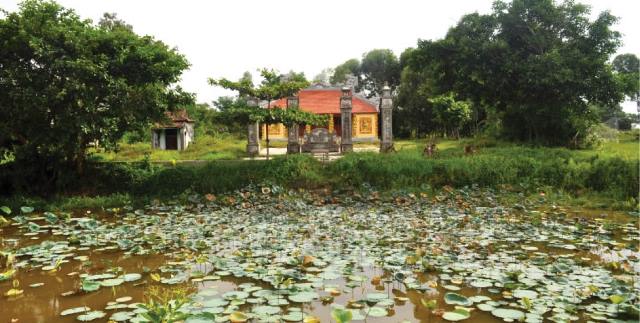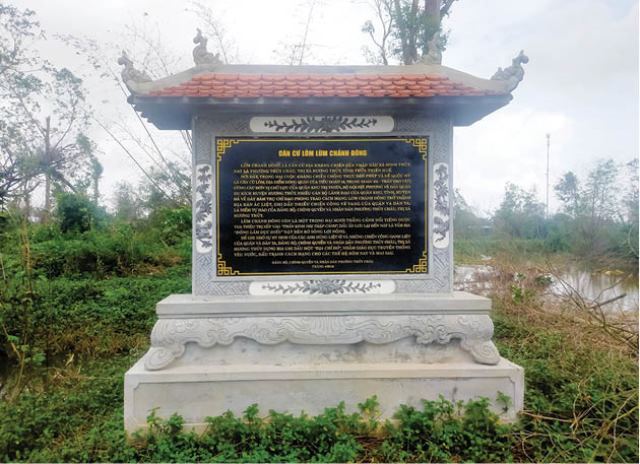Hundreds of years have passed, but the lines "In the forest, the flocks of birds come to converge / Down the flowing streams, the playful birds dived freely thru" in the poem "Dong Lam Winged Bird" by Emperor Thieu Tri still make people's hearts flutter and captivate their desires to discover.

Chanh Dong communal house. Photo: thuathienhue.gov.vn
An Cuu is a tributary of the Huong River south of Hue Citadel. The river has various names such as Loi Nong, Phu Cam, Dai Giang, Ha Tu, Cong Quan. The whole river is about 30 km long, taking water from the Huong River from the end of Da Vien islet, flowing through Hue city, Huong Thuy town, and then pouring into Ha Trung lagoon.
Since the day the Nguyen lords chose Kim Long and then Phu Xuan as the capital of the Inner Realm (Dang Trong), the two banks of An Cuu River were home to the residences and garden houses of mandarins and nobles. However, at this time, the river was still small, and many sections were shallow and narrow.
In the 13th year of Gia Long reign (1814), after surveying the situation and consulting the elders in Thanh Thuy commune, the An Cuu river was dug deeper and the Than Phu dam was built to collect water for irrigation and anti-salt intrusion for thousands of acres of fields here. In the 2nd year of Minh Mang reign (1821), the An Cuu river was renamed Loi Nong. In the 16th year of Minh Mang reign (1835) when the Nine Dynastic Urns (Cuu Dinh) was cast, the image and name of the river were engraved on Chuong Urn.

Stele of Lom Lum Chanh Dong Base. Photo: dulichhuongthuy.com
Nestled on the bank of Loi Nong, at the downstream of Than Phu is Dong Lam (forest in the east). Although not very large, due to the fertile and wild land, once there were many kinds of wild and forest trees, such as mung, bom, sung, bong-bong... proliferating and thriving. Thus, this place had a wild appearance and gathered many kinds of birds and animals, so it was worthy of being called a forest.
It was also Minh Mang who was the first Nguyen Emperor to built right in Dong Lam a palace to rest after traveling and hunting. By Thieu Tri's time, this palace being called Than Phu became more grandeur.
Remaining in many people's memory about the palace is a three-compartment, two-wing building, roofed with yin-yang tiles; a 5-compartment building built on the riverbank had a flat-tiled roof; a three-compartment, two-wing building with thatched roof and a system of corridors and protective walls.
From Hue to Dong Lam, we can follow road 1A, through Thanh Lam field, turn left and go along Provincial Road 10B for about 2.5km to Loi Nong Bridge. Then, turn left on Chanh Dong Street and continue for about 300m to reach the destination. If you wish to add a touch of romance, you can take a boat along the banks from An Cuu to Loi Nong, following the itinerary of excursions, hunting, and farm pleasures of emperors and courtiers hundreds of years ago.
From the bustling streets to the countryside, passing through many loving and quiet villages, where there are still bamboo banks and wharfs, boats and fish traps waiting for fish in the flood season, you will have wonderful moments of relaxation.
Dong Lam is also known as Lum Chanh Dong, a revolutionary base in the delta in Minh Thuy commune (now Thuy Chau ward, Huong Thuy town), formed quite early in the two resistance wars against the colonialists and empires, recognized as a historical relic at the provincial level according to Decision No. 3330/QD-UBND of the Provincial People's Committee.
Dong Lam - Chanh Dong is not far away. Please visit this place once. There are no more birds and wild animals like in the old days to hunt. There are also not many wild forest trees of a wild age. For a long time, it has been transformed into a peaceful village scene nestled by the clear and winding river.
Yet as the late autumn comes, why don’t you visit Dong Lam - Chanh Dong when sunset falls. You will feel like you are lost in the peaceful Hue countryside of the bygone days when our ancestors expanded the realm...
By Dan Duy
